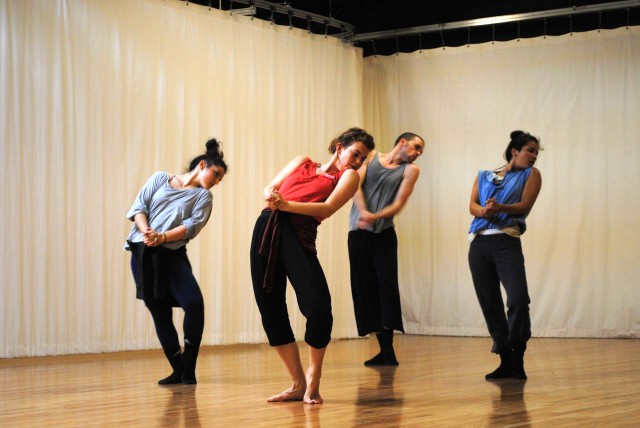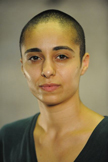 Ate9 dancers Genna Moroni, Ariana Daub, Taylor Knight, and Chantael Duke (Image: Danielle Agami)
Ate9 dancers Genna Moroni, Ariana Daub, Taylor Knight, and Chantael Duke (Image: Danielle Agami)
Friday night at the Century Ballroom, Seattle audiences witnessed “Sally meets Stu”, a new dance work from newcomer to Seattle Danielle Agami. Agami was previously with Israel’s Batsheva Dance Company, before a brief Gaga stopover in New York led her to the West Coast and a summer residency with Velocity.
In pulling together a troupe of dancers for her new work, Agami found a new dance company, Ate9, had crystallized–there’s something about Seattle, she says, that makes you want to take risks. (Seattle dancers Kate Wallich, Matt Drews, Erica Badgeley, Sarah Butler, and Chantael Duke have already signed on.)
I spoke with Agami at Octo Sushi, the cannily placed sushi joint that is about 15 paces from Velocity dance studios. Not yet 30, she has the self-possession of someone older, but she’s also engagingly candid–in the midst of our talk about “Sally meets Stu,” she says, “I wonder if I’m talented enough, that’s what I’m checking.” (These are words to make a critic’s pinched little heart beat faster–it’s not always the case that an art-maker bothers to ask that question.)
“Sally meets Stu” is not really about a Sally and a Stu, not even in terms of its text by Nadav Heyman, a 6′ 2″ former point guard for Corvallis High School, described even then as a “cerebral” player. (He also played at the University of Puget Sound.) The stories he tells are concerned with contingency and ramification: “all the alternative routes that romantic relationships might take over a lifetime,” as Michael Upchurch puts it. Heyman recites, and dances as well.
Agami claims she’s learned English mainly from watching TV, which perhaps accounts for her unselfconscious poetry when she says the dance is about finding “the edges of the human body.” She means tracking down the multitude of states we’re capable of, not just the usual buttons. She muses about a quiet alertness, “like an animal before it attacks.”
What dance can show us, she argues, is the way the dramatic climaxes to life are located in the body. In “Sally meets Stu,” some of that external setting of scene is provided by Heyman’s words, but the focus is on the performers’ expressions and responses: the elasticity of one woman, the bitchy shell of another. ”Simplicity is the best option,” she says, talking about her goal of a “perfect clear moment.” We can be too busy to notice, she muses, the “shock of subtlety.”
In “Sally meets Stu” rehearsals, Agami keeps slicing away at the extraneous–which often means that music vanishes, it’s just the dancers and the audience members. Maybe two men heave a woman back and forth like an encumbering sack of potatoes. Maybe a series of women run and leap into a partner’s arms–just that moment, so that your stomach lightens with fear and exhilaration.
But then, from somewhere, music and an ensemble dance erupts, a line of dancers stepping along, hands lightly forward of the pelvis, as if holding reins, weight back behind the heels. Maybe the ensemble arranges itself in three levels, like a soccer team with four defensive backs, and the lines thread between each other. It is unpredictable.
The troupe trains every day in Gaga, the movement language from Ohad Naharin, which challenges people to keep constantly in motion for up to 75 minutes at a time. Naharin has said it’s a healing practice, a way to break the rigidity of habit (and other trainings) and discover where atrophy has set in. The constant flow is a way of keeping your head out of it. The result in the Ate9 troupe is that each dancer has a distinct idiom, a movement personality, but there’s also a delight in group movements, where the choreography seems lit from within.
Gaga-inspired choreography is “less formal,” Agami says, more prompted by “emotion, tension, intention”–and from each dancer “shapes arise.” (She’s teaching Gaga to dancers and non-dancers at Velocity.) Putting on “Sally meets Stu” at Century Ballroom, where thousands have twirled and tangoed, felt right to her immediately. Here are two videos of the creative process:
The SunBreak is an online magazine of news & culture. A conversation about the things on Seattle’s mind.



